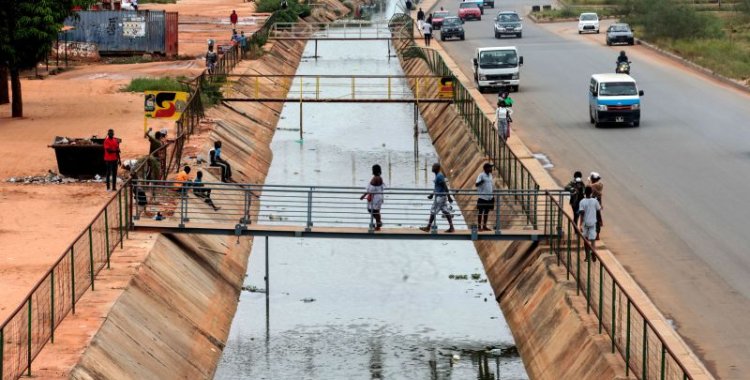This year alone, 30 people will have lost their lives there, 11 of them in a single accident, according to figures quoted in the report "Death Ditch - The silent weapon mounted by the government against its own population", produced by the Zango Library II Community Studies Center (CECBZ).
Residents of the area, like Adelia Adelino, who reports to Lusa a series of fatal accidents since 2016, fear more deaths if nothing is done.
"We call on society and the government to take care of us because these are really fatal accidents. From here, come out alive, only when it doesn't rain, because when it rains it fills", she says, desolated, pointing to the semi-alagated ditch with stagnant waters.
And there have only been no more deaths because they have "taken care of the children", she stresses.
Manuel Cunha stresses: "It's worrying".
The road is unsafe and "any car on the road falls straight into the ditch", the resident says, adding that "we have to be careful so that the worst doesn't happen", whether they're drivers or pedestrians, because "the protection for those on foot is not good either".
Raimundo Ngunza has already witnessed some accidents.
"It's regrettable the situations that happened here in this ditch, some time ago there was a family that lost its life in a very tragic way," he recalls, claiming that the fault lies with the "rotunda that is badly designed.
Raimundo reveals that it has often been the local population who have come to the rescue of the victims.
"The firemen come here and can't do anything, and neither can the police. They just stare and it's the young people here who give their all, their claw, to get people out of the ditch, who stay for hours and hours and only later do the firemen come to lend a hand", he tells Lusa.
And he laments: "It's very sad what's been going on in this ditch", asking for the pit to be filled in "as soon as possible".
The work began in 2016 and has already undergone some improvements, but the problems remain, stresses journalist Coque Mukuta, director of CECBZ, who produced the report in which he identifies causes of accidents and suggests measures to minimise the risks, calling on the competent authorities to take responsibility.
"With this report we have sought to alert the authorities to the danger of this ditch," he explains.
At the most dangerous point, revealed in the report and which Coque Mukuta points out, the semi-destructed metal fence is indicative of the collisions that took place there.
"Most fatal accidents happen along a single point, which we call a critical point here, where the road was badly designed," the report says.
At that point of the road, the tight and poorly signposted turn to make a U-turn is an invitation to disaster, and the tyres with reflectors placed there recently will be of little help.
"We had contacts with the authorities and the solutions they found are six tires, as you can see at this peak which is quite dangerous," says Mukuta, pointing to the place where 11 people from the same family, including eight children, died in March.
The journalist, trained in Management and Public Administration, suggests closing the detour, placing speed reducers with reflectors on that section and improving lighting, remembering that most accidents happen at night.
"Our goal is to alert about the danger of this peak and the quality of this work. We call on them to hold the culprits and the administration itself, which knows the problem and can't provide a solution," Mukuta criticises, pointing out that the country lacks a "culture of accountability" for "finding a culprit in this macabre work.
Barnabé Raimundo, assistant administrator for the technical area and infrastructure of Viana, recognizes the problem, but denies the responsibilities of the municipality.
"We are talking about a work that is not finished, it is being intervened", he told Lusa, adding that the infrastructure belongs to the National Institute of Roads of Angola (INEA) and only this entity will be able to do the necessary works to guarantee the safety of passers-by and motorists, which is currently not assured, either by bad visibility or excessive speed.
"For lack of visibility many hit the kerb and roll over, others fall into the ditch. We are also concerned about the deaths there and just this week we had a meeting to talk about this problem and press INEA for the work to be completed. We are very sorry about these deaths and we want our residents to transition safely in that area," he said.
In addition to the traffic accidents, several drowning victims were also recorded in the ditch, points out Coque Mukuta, pointing out the sludge that joins at the bottom as an additional danger.
Challenging the risk, some young people launch improvised lines to catch the small fish that swim in the still waters full of garbage.
Tito Alberto knows that the place is dangerous, but even that doesn't deter him from trying to catch something for his dinner.
"We already know, we are up here, when you slip you can die, but someone like me - I am a fisherman - is not going to die," he says, amid smiles.
Already Esperança João Francisco was indignant: "When we got here, the ditch was fine. We had no problems, ever since they opened this ditch, you can't do it. Cars fall inside, people die there" and it's a danger also for the children, the resident tells us.
She ends her speech with a simple request: "We just want you to close the ditch and stay as we were".







